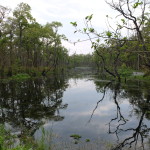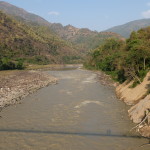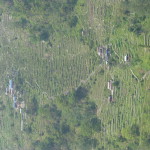
We’ve written before about the unrealistic expectations of visitors going on safari in Asia’s national parks (click here to read the article). During our three day visit to Chitwan National Park in the south of Nepal, we noticed something disturbingly different: a restlessness and lack of respect for the slower, quieter, and – we say this positively – relaxingly tedious side of nature compared to the non-stop distractions of city life.

We’ve seen the somewhat frantic mentality visitors bring to a park like Yellowstone in the northern US, ticking off the geysers, racing around the perimeter highway and braking to see the big animals, only content if they can get closer and closer to them. Worse yet, fewer and fewer Americans seem to be visiting the parks, detaching themselves more and more from the natural world.
Those that still go, there and here in Nepal, seem to be looking for just another form of entertainment, not something completely different. They seem to find it difficult to detune their minds to the slow pace and hushed noises of the outdoors. They continue to need to fill the gaps with talk or more instantly gratifying activity. Even the naturalists feel frustrated at the indifference.

We thought it particularly odd after spending close to two years in Asian countries. Across Asia, we found many urban dwellers still feel close to the land whether they farmed it themselves or still have family in the villages. And those relationships exist between the city dwellers of Nepal and their villages. After the April 2015 earthquake, we saw hundreds of busloads of city workers – a small portion of the overall flow – heading out of Kathmandu to their familial villages. In their normal lives, they demand freshness of produce, and disdain supermarkets and mass distribution, because they know the difference between commercialized and locally-grown edible food.

But the cultivation of land is still not quite the same, and often opposes, a delight in the raw, untilled world. Primary or secondary forests can be harvested for money; the land can be turned into paddies or plantations. It’s hard to savor the wild, when you’re working so hard to tame it. As many NGOs have found, it takes some careful program development to reconcile village needs with preservation.
At Chitwan, the local villagers have gained from jobs working within the park and the substantial inflow of tourist money. The young and restless that increasingly leave the villages for the city may not have had the chance to learn from those programs.

The tourist industry at Chitwan doesn’t help foster greater respect either. Agents book visitors for two nights, during which they are bustled around from activity to activity. Canoe rides promising to take you away into the quietude of a slow moving river last just 45 minutes before you’re on to something else. The family on our long boat couldn’t stop chatting.

The much touted elephant safari is supposed to bring you close to rhinos, deer and other mammals. Elephant are surprisingly stealthy, and other animals pay little attention to them. But the safari proved to be a form of mass transit, as a large pack of pachyderms loped along through the bush carrying hundreds of tourists in groups of fours, all mounted in sturdy cages on top.

The exercise is nearly pointless. The tourists keep gabbing noisily with each other and with the elephant drivers, indifferent to anything but the big game – deer, rhino, other elephants in the pack. None noticed the large, impressive hornbill swooping by. We did see those mammals, but seeing the rhino required the whole herd to race after it, much to the delight of the tourists but quite likely a great deal of stress to the rhino. The photo-ops matter most – often not so much of the animals, as of each other in the cages.

Even on our two-hour walking safari, where quiet was the rule, we had to dodge several other noisy groups who seemed bored even by a much less stressed rhino bathing lazily amid a still lake, itself a perfect mirror of the many slender trees on the water’s edge. The rhino was too far off; too boring. And, for them, traipsing thru the dull forest just seemed to take too much time for too little entertainment.

We were fortunate in choosing one option for getting away from the crowd, a private jeep safari for an entire day. We could stop at will (signalling the driver with the tap of a rock on the roll-bars), linger, watch and listen for birds, drink in the landscape in a way that none of the packed jeeps on a half-day tour could do. They followed a set route and kept trailing each other.

During the day, we found eight of the park’s rhinos including one who crossed the path right before us; nearly 80 different bird species; mugger crocodiles and their cousin gharials, and a host of different deer. When we saw another jeep on the way back home, most of the packed in visitors look bored. Toward day’s end, one called out, “Did you see anything?” We were speechless.

Just to round out the experience, we even endured a wild hail and lightning storm, taking shelter from our open jeep under a rickety old watchtower, then clutching a tarp over our heads as we literally rode out the rainstorm in the fast moving jeep. Nature can be quite exciting after all.

Before our Chitwan visit, we had rafted the alternating white water and slow-moving pools of the Trishuli River (pretty much at the epicentre of that earthquake a week later). Here too, entertainment and thrills seemed the main attraction. The rapids got up to a 3 or 4 level, a heart-accelerating challenge but not much danger. That’s what the people in our boat seemed to like best, though all delighted at the chance to float alongside the raft within the calm portions. Another boat – fortunately far ahead of us – was filled with camera crewmen doing some story and carousing noisily down the river.

Maybe some of the natural feel of the landscape was compromised by the proximity of the national highway, a busy road loaded with honking buses and trucks on their way between Nepal and Delhi. Even the campground at which we spent the night was filled with their racket.

But apparently few people do the lower section of the river; we were alone with our raft handler all day. It’s not thrilling enough: lesser rapids, no highway for long periods, just wonderful quiet and greenscape. We watched kingfishers dart about, and monkeys play. We watched nothing happen, but the passage of the raft between ebony boulders polished over eons.

Up in the trails running to the Himalayas, you might think, everyone would be smitten by the grandeur of the peaks around them and the vertiginous valleys below. Yet people seem distracted in a different way. They’re all working so hard at their respective challenges, there’s only so much attention they can pay to the landscape.

Trekkers, mostly Europeans and Aussies, swarm these trails during the season. We did part of the Annapurna Circuit, a roughly 10 day trek to the base camp of Annapurna peak. We saw some hikers press on intently, daring the ups and downs and the demands of the higher elevations. Others keep the trip a social experience, gabbing away. A young French group we passed seemed to glance at the hillsides occasionally while maintaining non-stop conversation.

Not all are young. We saw a few family groups with plucky pre-teens in tow. We passed quite a number of wiry grey-haired women, some in a German group, others from England along with a single game husband, and one from Sausalito who was an inveterate visitor to these trails. When these people stop, they typically stop to catch their breath, not inhale the grand terrain.

A large number of the hikers are actually paid workers. Most trekkers hire a guide to lead them up the hillsides and keep things on track, so to speak. And also sherpas, local men who weigh perhaps 50 to 60 kilos, wearing sandals or worn sneakers, who haul 35 to 40 kilo loads of the visitors’ stuff up and down the trails as fast as the trekkers go. A smaller contingent go it alone, carrying their own loaded backpacks.

These hikers may be working hard, but, for much of the Annapurna Circuit, they are walking through an actual workplace. The residents here have long tilled the steep hillsides, etched throughout with terraces for vegetable growing. As a hiker, until you reach an untillable altitude, you are never far from cultivation.

That’s why much of the Annapurna circuit consists of stone walkways and stone steps, the result of countless man-hours, assuring reliable access to the terraces and from village to village. For the villagers, it’s more work maintaining these stony trails. We passed three locals, including an elder man and young woman, take apart a huge tree trunk threatening the path, then carry the heavy pieces on their backs to be cut up and sold down valley.

Trains transport goods back and forth – noisy donkey trains – clambering by to a chorus of ringing bells draped around the donkeys’ necks. They carry supplies up the mountains and seem dedicated to bringing back, among other things, the innumerable empty beer bottles finished off by the trekkers.

Together with the goats seeking greener pastures and the water buffaloes bullying their way to seek food, these animals leave a lot of deposits on the trail.

For the trekkers, the stone trails are definitely a mixed blessing. They keep the trails walkable despite the weather, but they seem to take a toll on all visitors. Climbing into and out of the valleys involve taking thousands and thousands of steps, steep steps, relentless steps, steps trekkers have nightmares and aching muscles from, long after they’ve gone.

It’s a temptation to romanticize the traditional work of the mountain villagers as part of the natural landscape, but it’s harder to ignore the commercialized support system the villagers have introduced to accommodate the many trekkers. Useful, but also a somewhat diminished outdoors experience akin to the national highway and campground along the Trishuli.

One village in which we stayed, Ghandruk, offered 20 or so guesthouses and hostels. It was hard to find the actual village in all that. Other villages seem to be transformed into an array of convenience stores and restaurants – innumerable way-stations for the hungry, thirsty or exhausted foreigner.

Tending to the tourists seems to be a lot easier for the villagers, and seasonally more lucrative, than wrestling with the land in order to yield up barley or rice or corn. Offering electricity, mobile phone service (the new necessity of life) and even wi-fi, the villages cater to the distractions and amenities that draw more visitors.

Little by little, you find yourself in an economic network of accommodations, supplies and connectivity…all in the name of tackling that natural world of the renowned Himalayas.

Somewhere in all this, we feel, nature has been lost – whether on elephant safaris in Chitwan or shooting the rapids on the Trishuli or walking the Annapurna. Will the next generations want the untamed version of nature, foster its wildness and its quietude, or respect its wonders? Or will they continue to seek from it more and more entertainment – thrills, challenges, social outings and civilized comforts? Who will want the natural world when the unnatural version becomes so appealing?
(Also, for more pictures from Nepal, Tibet and Bhutan, CLICK HERE to view the slideshow at the end of the Nepal-Tibet-Bhutan itinerary page.)







I’m as disappointed as you are.